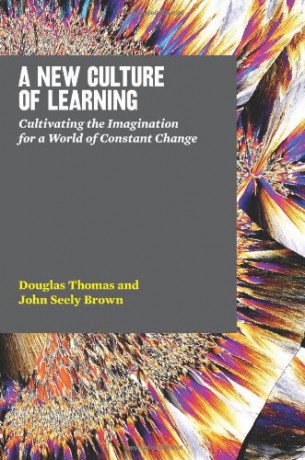- Home
- Articles
- Reviews
- About
- Archives
- Past Issues
- The eLearn Blog
Archives
| To leave a comment you must sign in. Please log in or create an ACM Account. Forgot your username or password? |
|
Create an ACM Account |

May 10, 2011
In 2008 I began work with a number of friends on a conceptual model of a "learning architecture" that would enable a whole generation of connective technologies, which could be used for augmented reality and shared experiences. Central to this is the idea that each of us constructs our understanding of the world in terms of people, places, and shared experiences. Sounds cool, right? Well, a challenge I constantly have is articulating what this means in language that captivates the imagination of broad audiences.
Thankfully, Douglas Thomas and John Seely Brown have captured the very essence of what it means to learn and play in a world that is constantly changing. If you're only going to commit to reading five books in 2011, put A New Culture of Learning (2011, CreateSpace) at the top no matter what you do for a living; whether you have kids or not.
Many organizations (including the ones I work with) are focused on creating a world such as Thomas and Brown describe. It's worth it to you to have a picture in your mind's eye of what will be mainstream learning over the next 30 years.
One of the most important shifts suggested in A New Culture of Learning concerns how we think about our presence. The Internet, our friends, our moms—all seem to have an endless supply of horror stories about privacy. Thomas and Brown address this as "Personal" combined with the "Collective." Here is an excerpt from the book:
"The personal is the basis for an individual's notions of who she is (identity) and what she can do (agency). It is not necessarily private, though it may be, and it does not exist in a vacuum� The notion of 'the public' is singular, and it implies a sense of both scale and anonymity. The notion of a collective is narrower. Collectives are made up of people who generally share values and beliefs about the world and their place in it, who value participation over belonging and who engage in a set of shared practices�"The balance of personal with collective is important, as is the distinction between collectives and (enter a popular buzzword) communities. Thomas and Brown assert that while communities can be passive, collectives can't. Their distinction, in terms of learning, is pretty straightforward: "In communities, people learn in order to belong. In a collective, people belong in order to learn." I find the description the authors give of learning with the collective very similar to self-organizing principles described by Dee Hock in One of Many.
Another gem in A New Culture of Learning deals with another buzzword you've no doubt heard: context. Shifting what questions to where questions don't just underscore the importance of context as a critical dimension to this new culture of learning; it illuminates the need to make and the need to play with knowledge. Many of you are no doubt using LinkedIn, Facebook and Twitter to engage with other professionals. Some of you might also have access to social networks and collaboration spaces in your workplace. Thomas and Brown write, "Where one chooses to post, where one links to, or where one is linked from does not just serve as a locus for finding content. It becomes part of the content itself�. Through the process of making, we are also learning how to craft context so that it carries more of the message, which helps solve many of the issues of information overload."
Think about that last part for a moment. Do you post your blog at certain times of a day, even on certain days, to attract more of an audience? Have you begun to sense that some of your LinkedIn groups are more responsive to certain types of questions than others, and have you started reaching out to those groups both to share what you know, and to seek their counsel? This practice—this know-how—is the very basis of evaluation and judgment presented in A New Culture of Learning .
At a very readable 117 pages, take this book to your favorite coffee shop in the morning and enjoy it from cover to cover by dinner-time. I suggest having a highlighter and a pen with you to write in the margins as you go. You should start applying much of what's in this book to your life and your organization now. Schedule yourself out of another endless day of status meetings and get your learn on. "They" will thank you for it.
Aaron is the Chief Learning Officer of his consultancy, Problem Solutions. In this capacity, Aaron is the Community Manager for Advanced Distributed Learning (ADL), an applied research and development initiative through the U.S. Department of Defense, innovating a next generation of advanced, broad application learning technologies. He blogs at aaronsilvers.com and can be found on Twitter as @aaronesilvers.
|
To leave a comment you must sign in. |
|
Create an ACM Account. |